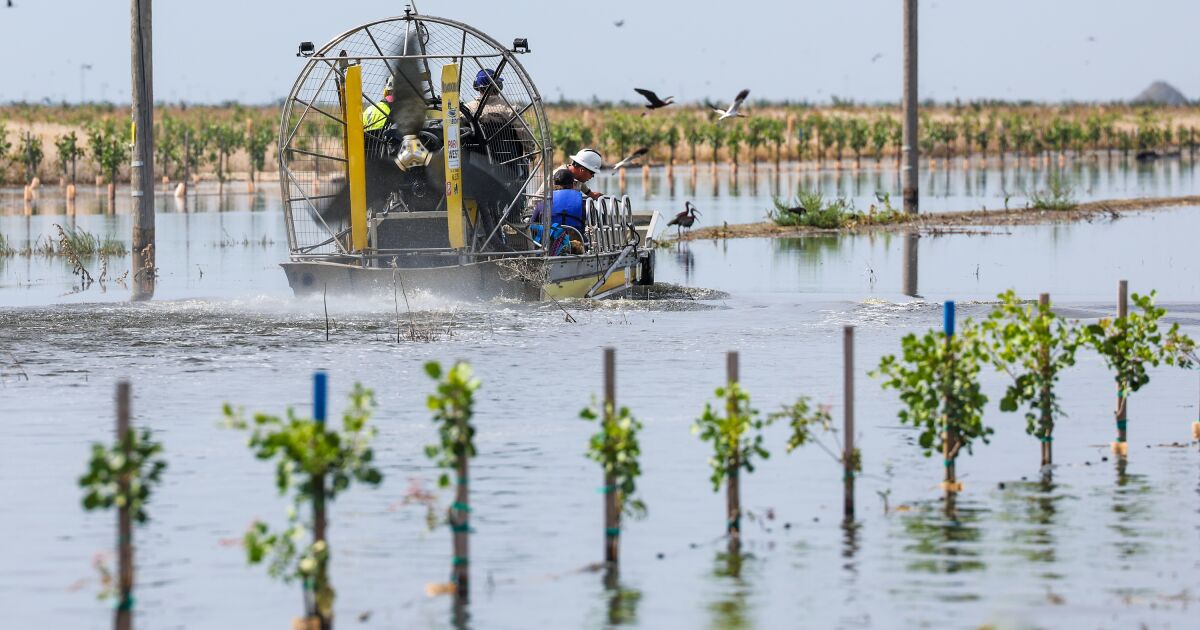A few years ago, Makram Hanna took his savings from years of work in real estate and decided to make a big investment together with relatives and two other families. They bought 1,270 acres of farmland in Kings County, and in 2021 they planted pistachio trees.
Many of those trees, which have yet to produce a crop, now sit under 2 feet of water.
“It’s a disaster,” Hanna said, standing with arms crossed beside rows of inundated pistachio trees. “Huge losses.”
Jose Pineda squeezes a handful of dirt to check its moisture content as he tends to Makram Hanna’s pistachio orchard.
(Robert Gauthier / Los Angeles Times)
The floodwaters cover hundreds of acres on the farm. Hanna fears that many of the trees will not survive.
The return of Tulare Lake after this year’s major storms has left Hanna and his family with a costly ordeal — and many questions about how they might be able to recover from the loss.
“To see everything we worked for going down the drain, it’s very hard,” he said. “We have to think about the future, and where we get funds to rebuild our farm. It’s very difficult.”
The lake has reappeared previously in wet years, such as 1969, 1983 and 1997. And many of the fields that have flooded were planted with seasonal row crops such as tomatoes, cotton and safflower. For these types of crops, growers can simply evacuate sprinklers and other equipment to wait out the flooding.
Tree crops, however, sustain more costly damage. And in recent years, landowners have planted more pistachio orchards around the Tulare Basin as well as other parts of the San Joaquin Valley. Some of those orchards turned out to be vulnerable when rivers swollen with runoff broke through levees and inundated farmlands.
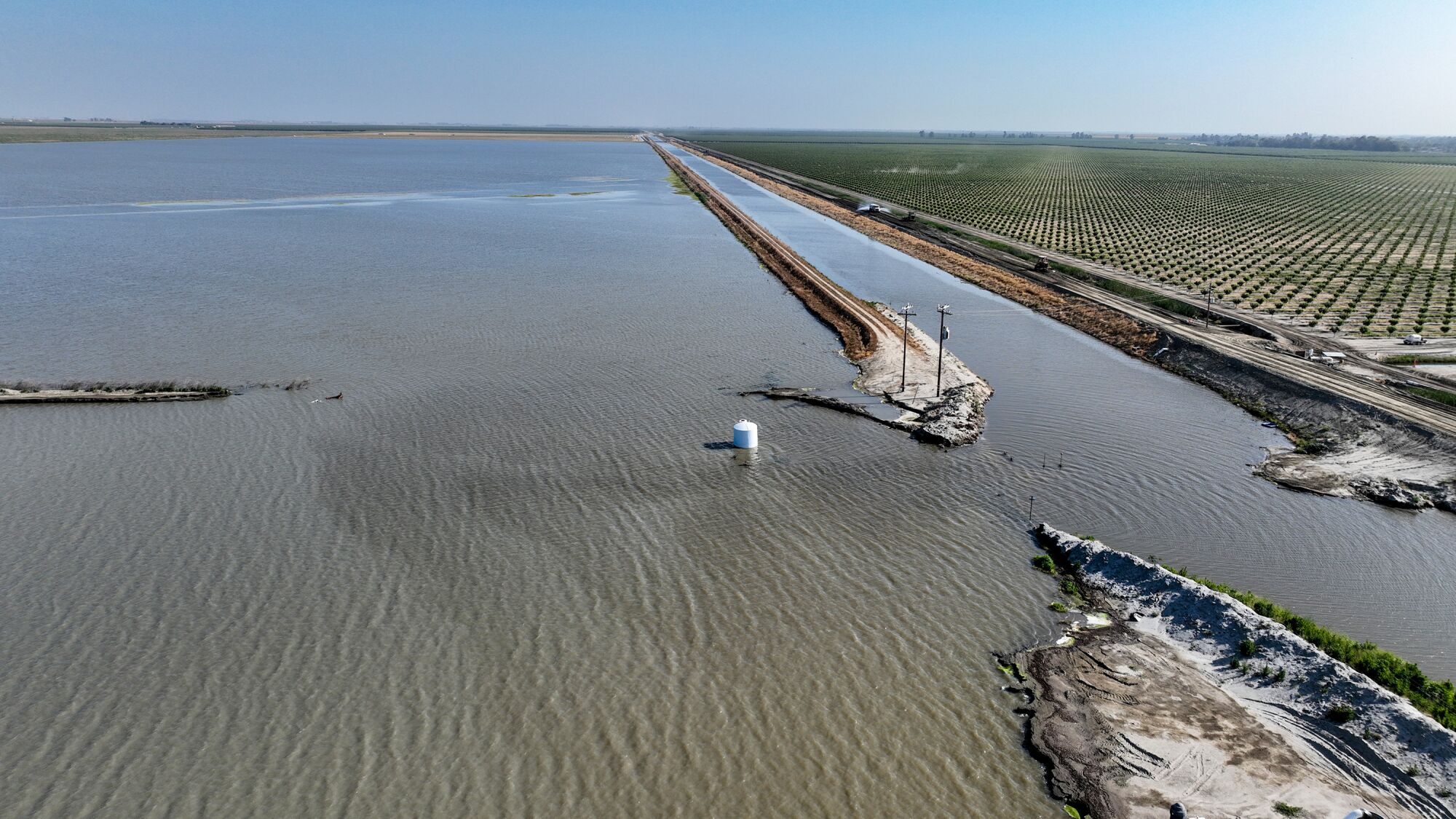
A breach of the Boyett Levee flooded hundreds of acres of Makram Hanna’s pistachio farm. The breach allowed water to flow from the surging Tulare Lake, left foreground, inundating the orchard.
(Robert Gauthier / Los Angeles Times)
For Hanna, who commutes to the farm each week from his home in San Diego County, dealing with the flooding and trying to save the remaining trees presents a stressful challenge.
The 68-year-old immigrated to the United States from Egypt in 1979, and he said overseeing the pistachio farm often reminds him of his childhood, when he worked during summers on his grandmother’s small cotton farm.
Months ago, he would enjoy walking through the rows and inspecting the trees. But lately, he is intent on finding ways to limit the damage.
“My focus is to find a solution for this disaster,” Hanna said. “What do we need to do not to lose everything? Because right now, it seems like we are about to lose everything.”
Of the more than 1,200 acres of pistachio trees on the farm, Hanna said, more than 800 acres are flooded, while about 450 acres are dry or nearly dry.
On a recent afternoon, Hanna was strategizing how to get a diesel motor working to pump water to irrigate dry areas of the farm and keep those trees alive.
He said he also has been grappling with other questions: “When the water is going to recede. And where are we going to get the money to rehab our ranch? And should we rehab the ranch? Is it salvageable?”
If Hanna and his partners decide to take out dead trees and plant new ones, the cost would be high. Replanting a single acre of pistachios can cost roughly $20,000.
Hanna said the farm has a liability insurance policy, but he doubts it will cover much, if any, of the flood damage.
He said he expects his family and their partners will need to shoulder substantial losses.
“What do we need to do not to lose everything? Because right now, it seems like we are about to lose everything.”
— Makram Hanna
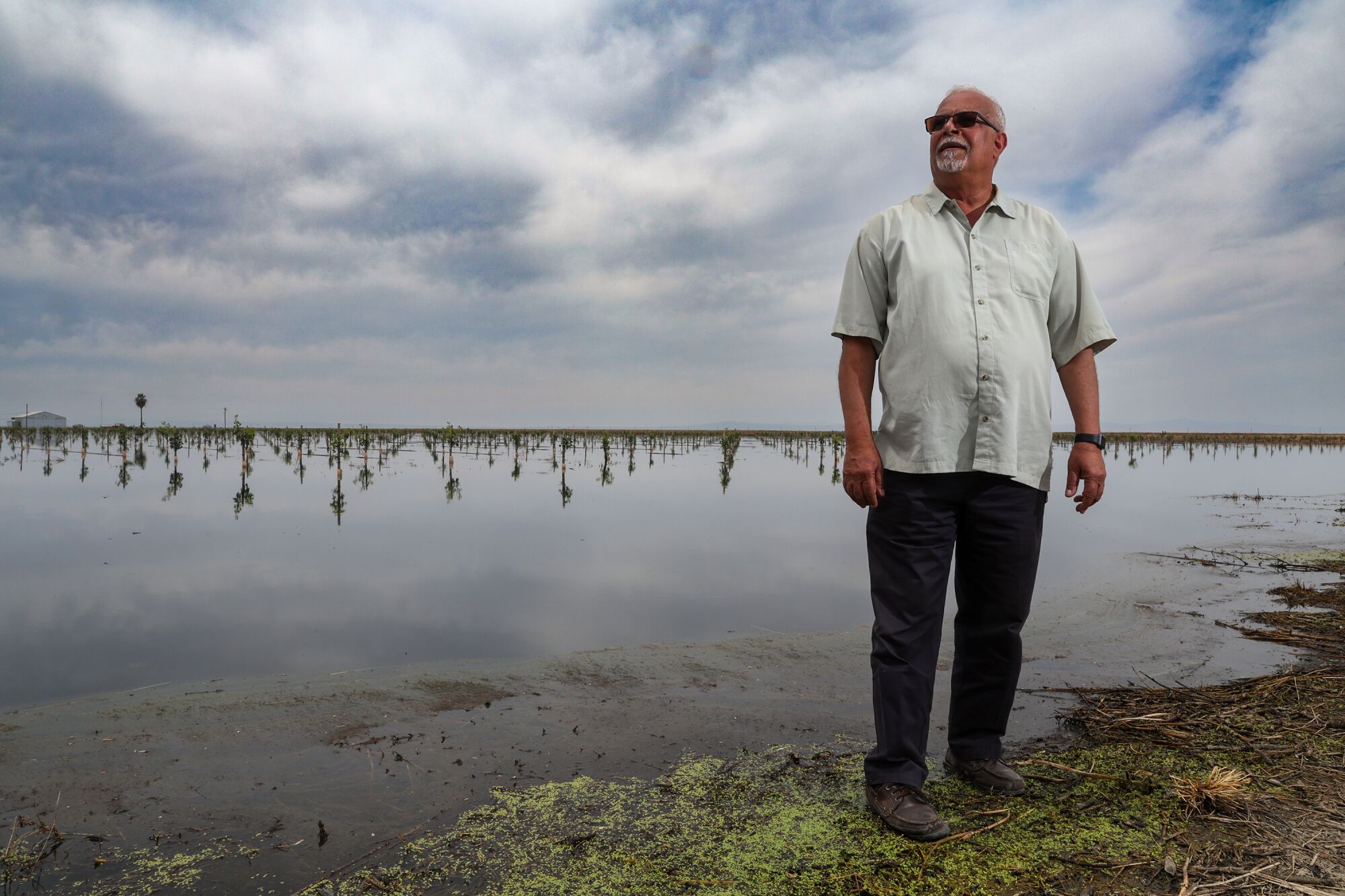
Farmer Makram Hanna stands beside his flooded pistachio orchard.
(Robert Gauthier / Los Angeles Times)
“All my savings, all my inheritance, and all my brother and sister’s inheritance, it’s all right here,” Hanna said.
For Hanna, the flooding has come as a sudden shock after years of successes in business.
As a young man, he studied molecular biology at Cal State Northridge, and later did odd jobs from construction to bussing tables. He eventually got into selling real estate, including auto shops and buildings at business parks, and also developed gas stations.
“I lived the American dream,” Hanna said. “The reality is, no matter what the work is, just be persistent and you’ll succeed.”
The pistachio farm isn’t Hanna’s first agricultural venture. He started in the early 2000s with 40 acres of wine grapes in Madera, and farmed it on his own until he decided to pool resources with relatives and two other families to invest in the farm near Corcoran.
Hanna said they studied the area before deciding to purchase the land.
The farm was being used for row crops at the time. But Hanna and his partners saw that neighboring farms were planted with almonds and pistachios, and they decided on pistachios.
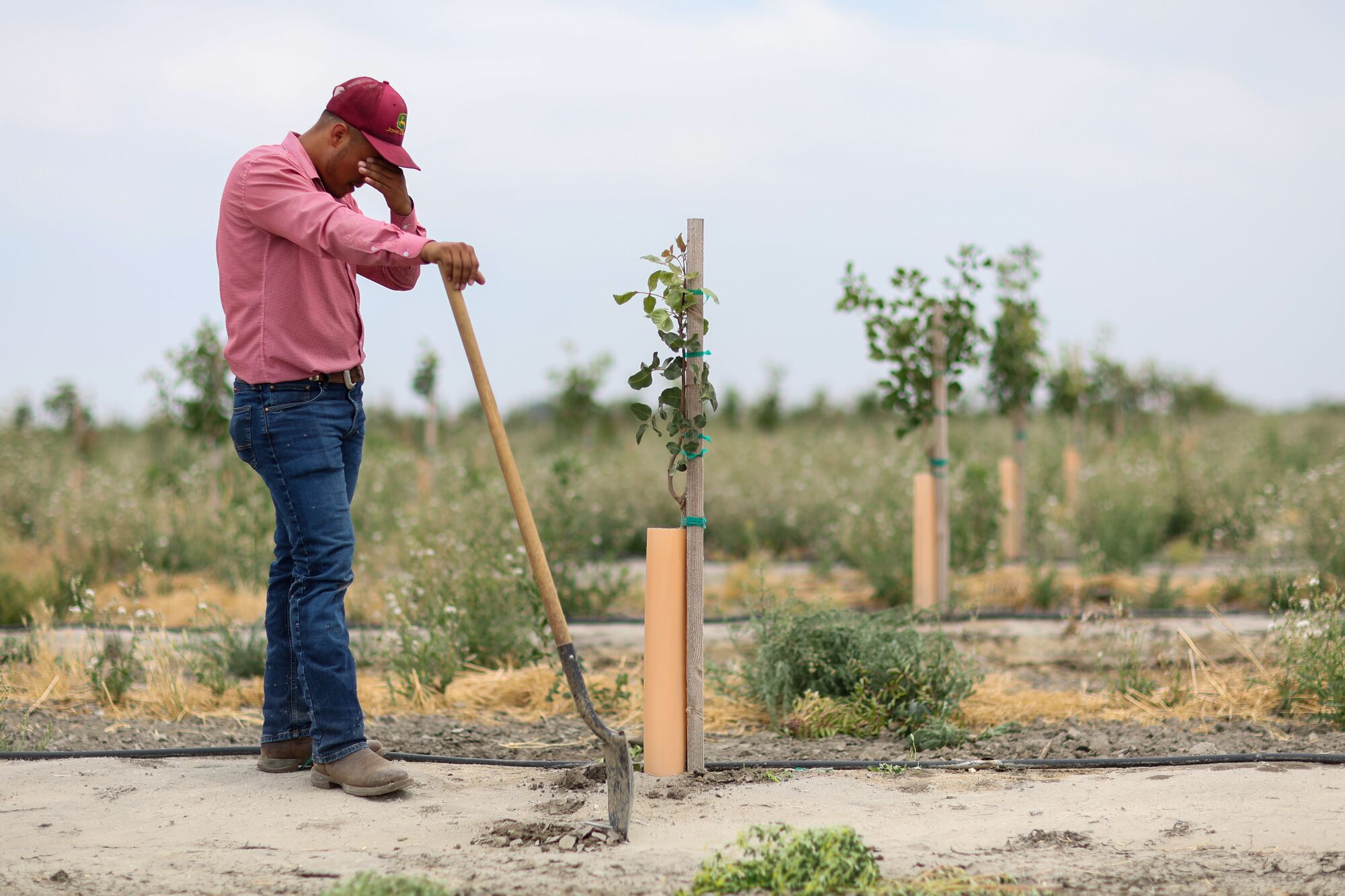
Farm manager Jose Pineda pauses while tending to young pistachio trees near Makram Hanna’s flooded land.
(Robert Gauthier/Los Angeles Times)
Many other farmers have made the same decision over the past two decades, planting pistachios or almonds in place of other crops. Between 2002 and 2022, California’s total pistachio acreage skyrocketed from 106,000 acres to 554,000 acres. In addition to being profitable, pistachios are hardy trees that can thrive with moderately salty water and soil, which is widespread in parts of the valley.
Hanna said another reason he wanted to plant pistachios is that he sees the nuts as an “environmentally friendly” crop. He touted the trees’ ability to sequester carbon and said his farm’s water use — about 2.7 acre-feet per acre annually — was less than fields producing three rotations per year of tomatoes, cotton and corn.
Hanna said he wasn’t aware of any previous flooding on the land. A map of the 1983 flood, however, shows the property was inundated during that reappearance of Tulare Lake.
In May, as floodwaters rose, Hanna inspected the levee that protected the farm. It was built decades ago by farmers, and he said an engineer told him it was going to break.
When the levee finally gave way on May 23, water poured through the breach onto the farm, inundating the trees.
Hanna was flying back to San Diego on a commercial flight, looking down at the area from a window seat, when he saw the floodwaters rushing onto his farm.
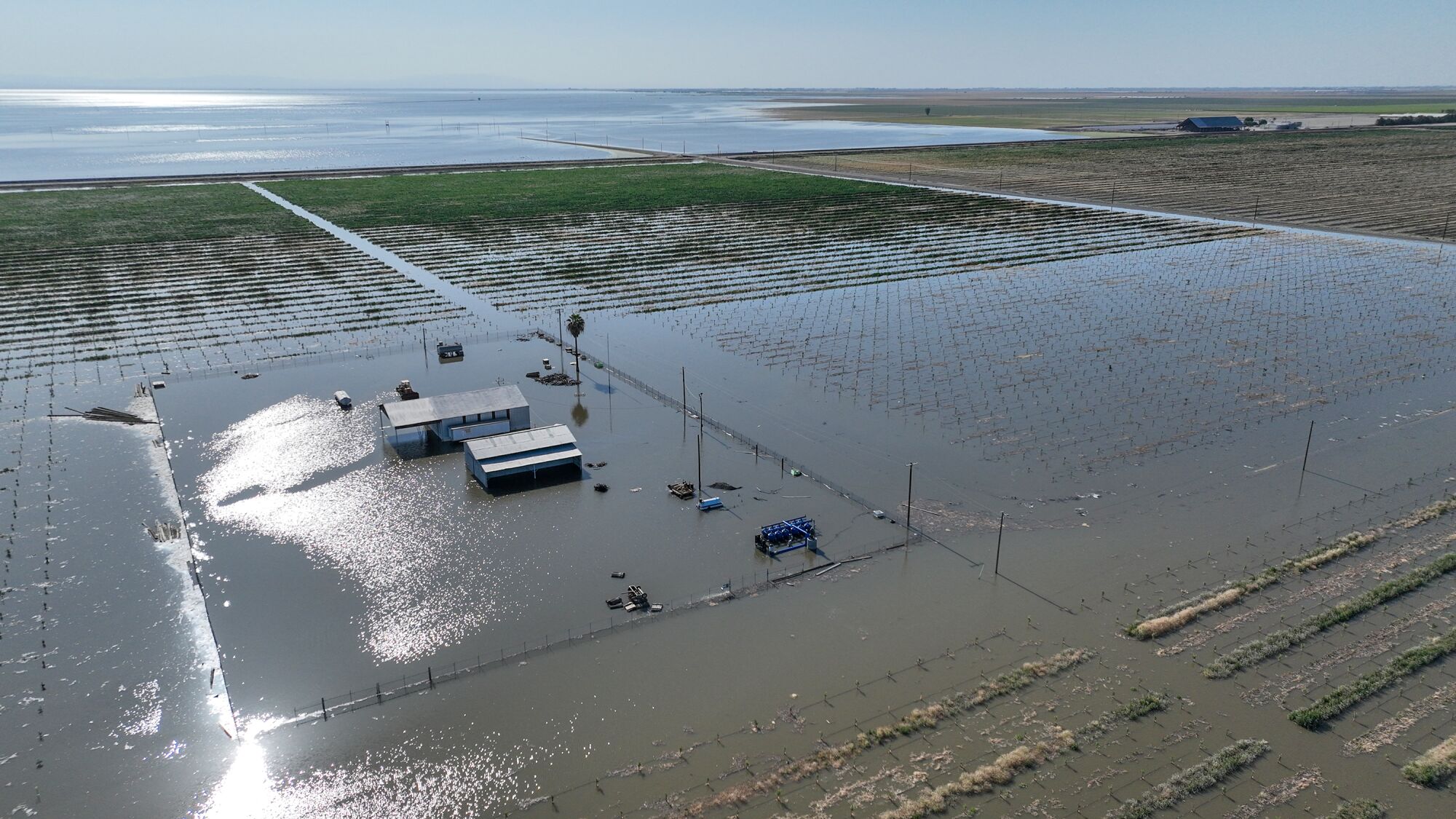
An aerial view of Makram Hanna’s flooded pistachio orchard after a breach of a nearby levee allowed water from Tulare Lake to flow onto the property.
(Robert Gauthier/Los Angeles Times)
“The intrusion of the water after the levee broke was violent, and there is no way you could control it,” Hanna said.
As he spoke, the pond beside the orchard was filled with wading birds, including avocets and black-necked stilts. The scent of marshy mud hung in the air.
Nearby, a work crew from the California Conservation Corps was reinforcing the levee that protects the city of Corcoran.
In the distance, the hum of an airboat emanated from the lake. PG&E crews on airboats were out removing equipment from power poles after shutting off electricity in the area.
Anticipating the flooding and the loss of power, Hanna’s workers had moved pumps and installed the diesel motor. In early June, Hanna said he was trying to have a diesel tank placed next to the motor to get some pumps working again.
Three weeks later, Hanna said workers were trying to fix the levee and were pumping water out of the flooded part of the orchard.
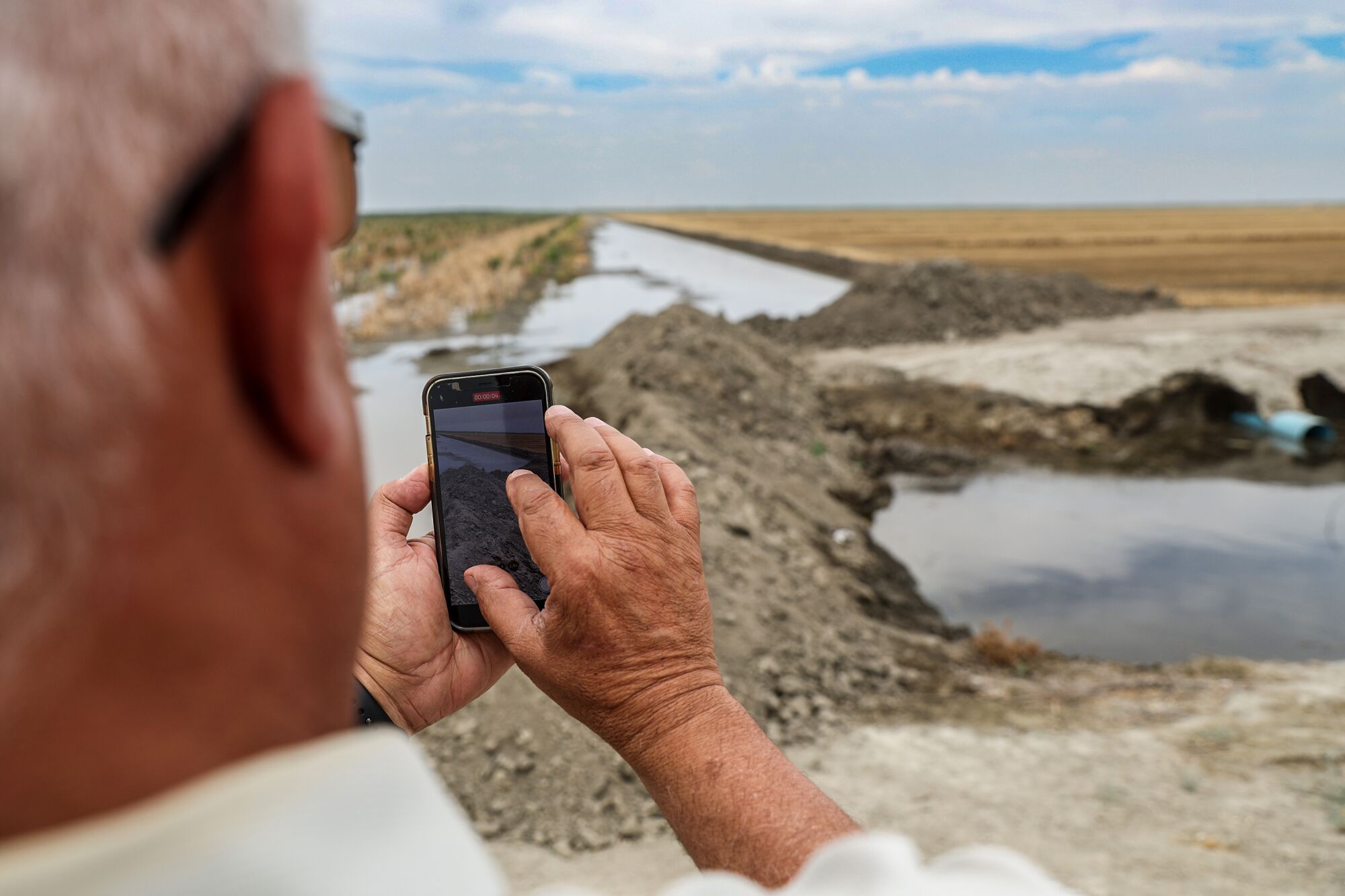
Farmer Makram Hanna snaps a photo of a berm he says a neighboring farmer built to prevent surging floodwater from reaching a wheat field, right.
(Robert Gauthier/Los Angeles Times)
“We’re not giving up. This may completely bankrupt us, but we don’t want to fail to try,” he said.
Hanna said he is thankful that a third of the farm has been spared by the floodwater, which has begun to recede.
“I hope and pray that it would get better,” he said.
Hanna, a Coptic Christian, said his wife has sought to reassure him by reminding him that “it’s all tangible.” Still, Hanna said the worries are hard to escape, and he’s been having trouble sleeping.
“I only slept two hours last night,” he said. “It’s stressful. But you know, I have my family and have my faith, and that helps. And I have good partners, too.”
Beyond his own situation, Hanna said he is concerned that California hasn’t been investing enough in water infrastructure projects, such as a long-discussed plan to increase water storage by raising Pine Flat Dam.
Had that dam been raised by 12 feet as proposed, Hanna said, “It would be very meaningful to everybody, to every farmer in that area.”
He said he thinks this type of project would help as climate change brings more intense floods.
“If we have control over that water, we wouldn’t have the dismal problem that we are facing right now,” Hanna said.
Some other people in the area, including leaders of the Santa Rosa Rancheria Tachi Yokut Tribe, have suggested setting aside some farmland to allow the lake to remain instead of draining it again.
But Hanna said he thinks if Pine Flat Reservoir were expanded, more water could be stored and released gradually to replenish the area’s depleted groundwater and sustain agriculture and wildlife habitats.
“Government needs to take charge and inject capital to build water projects that benefit our environment, our residents and farmers,” he said.
While struggling with the flooding, Hanna said he has continued paying farmworkers. He was talking with a contractor about bringing a crew to prune trees and do other work.
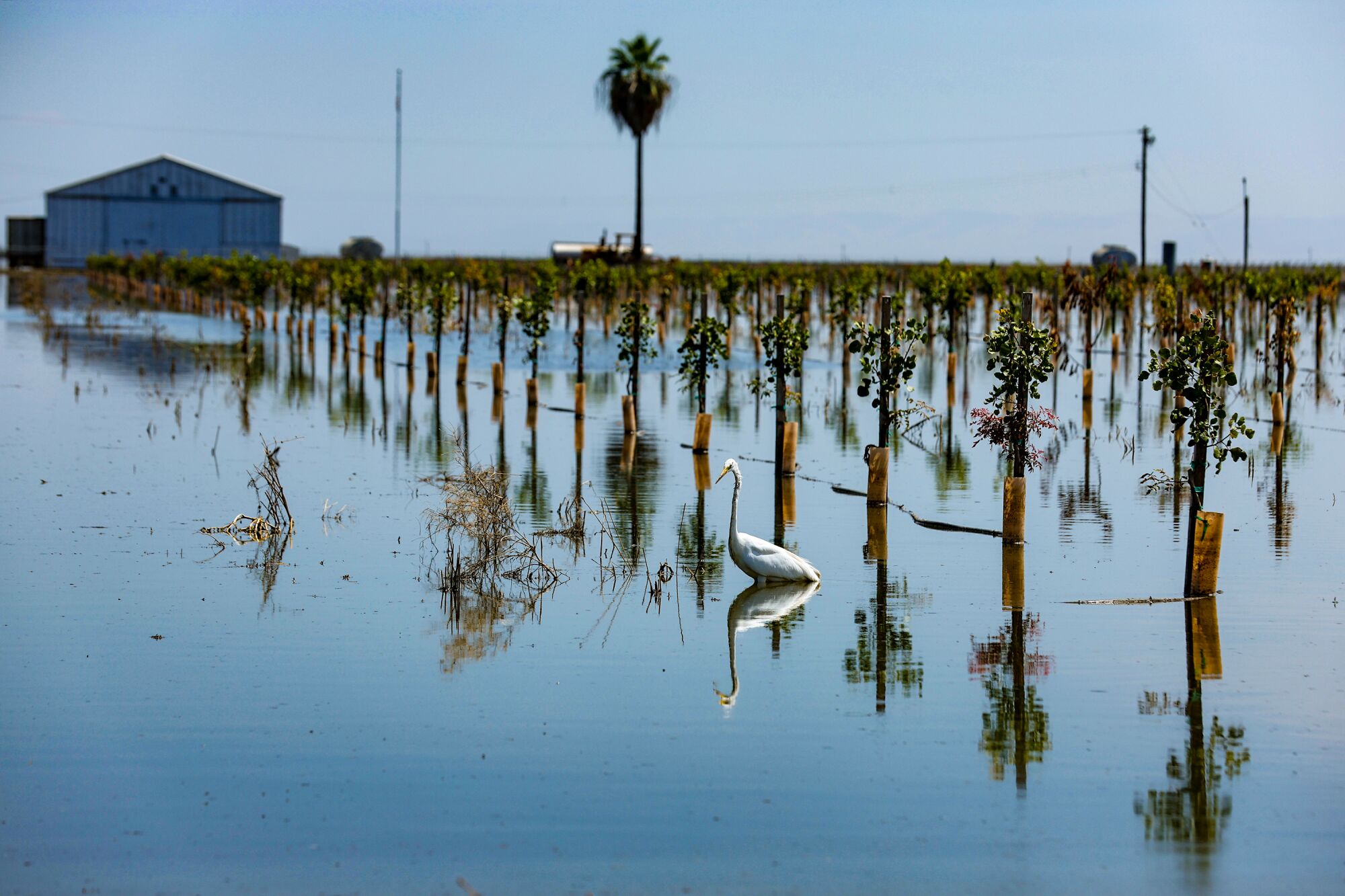
Birds, such as this great egret, have been foraging in the water at Makram Hanna’s flooded pistachio farm.
(Robert Gauthier/Los Angeles Times)
“By the grace of God, we have two fields here that are being saved,” he said. “As far as I’m concerned, they are saved. So we’re going to start working on them.”
As for the trees that remain underwater, Hanna said he doesn’t know how many might be lost.
“The reality is, we’re going to have to wait it out and see what will happen,” he said.
This story originally appeared on LA Times

